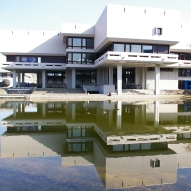 ; van den Berg, Marten E. ; Kaess, Bernhard ; Nelson, Christopher P. ; Bastiaenen, Rachel ; De Bortoli, Marzia
; van den Berg, Marten E. ; Kaess, Bernhard ; Nelson, Christopher P. ; Bastiaenen, Rachel ; De Bortoli, Marzia  ; Rossini, Alessandra ; Deisenhofer, Isabel ; Stark, Klaus ; Assa, Solmaz ; Braund, Peter S. ; Cabrera, Claudia ; Dominiczak, Anna F. ; Gögele, Martin ; Hall, Leanne M. ; Ikram, M. Arfan ; Kavousi, Maryam
; Rossini, Alessandra ; Deisenhofer, Isabel ; Stark, Klaus ; Assa, Solmaz ; Braund, Peter S. ; Cabrera, Claudia ; Dominiczak, Anna F. ; Gögele, Martin ; Hall, Leanne M. ; Ikram, M. Arfan ; Kavousi, Maryam  ; Lackner, Karl J. ; Müller, Christian ; Münzel, Thomas ; Nauck, Matthias ; Padmanabhan, Sandosh ; Pfeiffer, Norbert ; Spector, Tim D. ; Uitterlinden, Andre G. ; Verweij, Niek ; Völker, Uwe ; Warren, Helen R. ; Zafar, Mobeen ; Felix, Stephan B. ; Kors, Jan A. ; Snieder, Harold ; Munroe, Patricia B. ; Pattaro, Cristian ; Fuchsberger, Christian ; Schmidt, Georg ; Nolte, Ilja M. ; Schunkert, Heribert ; Pramstaller, Peter P. ; Wild, Philipp S. ; van der Harst, Pim ; Stricker, Bruno H. ; Schnabel, Renate B. ; Samani, Nilesh J. ; Hengstenberg, Christian ; Dörr, Marcus ; Behr, Elijah R. ; Reinhard, Wibke
; Lackner, Karl J. ; Müller, Christian ; Münzel, Thomas ; Nauck, Matthias ; Padmanabhan, Sandosh ; Pfeiffer, Norbert ; Spector, Tim D. ; Uitterlinden, Andre G. ; Verweij, Niek ; Völker, Uwe ; Warren, Helen R. ; Zafar, Mobeen ; Felix, Stephan B. ; Kors, Jan A. ; Snieder, Harold ; Munroe, Patricia B. ; Pattaro, Cristian ; Fuchsberger, Christian ; Schmidt, Georg ; Nolte, Ilja M. ; Schunkert, Heribert ; Pramstaller, Peter P. ; Wild, Philipp S. ; van der Harst, Pim ; Stricker, Bruno H. ; Schnabel, Renate B. ; Samani, Nilesh J. ; Hengstenberg, Christian ; Dörr, Marcus ; Behr, Elijah R. ; Reinhard, Wibke | Dokumentenart: | Artikel | ||||
|---|---|---|---|---|---|
| Titel eines Journals oder einer Zeitschrift: | JCI Insight | ||||
| Verlag: | AMER SOC CLINICAL INVESTIGATION INC | ||||
| Ort der Veröffentlichung: | ANN ARBOR | ||||
| Band: | 4 | ||||
| Nummer des Zeitschriftenheftes oder des Kapitels: | 23 | ||||
| Datum: | 2019 | ||||
| Institutionen: | Medizin > Institut für Epidemiologie und Präventivmedizin > Lehrstuhl für Genetische Epidemiologie | ||||
| Identifikationsnummer: |
| ||||
| Stichwörter / Keywords: | GENOME-WIDE ASSOCIATION; CORONARY-ARTERY-DISEASE; J-POINT ELEVATION; VENTRICULAR-FIBRILLATION; METAANALYSIS; MUTATION; S422L; GWAS; | ||||
| Dewey-Dezimal-Klassifikation: | 600 Technik, Medizin, angewandte Wissenschaften > 610 Medizin | ||||
| Status: | Veröffentlicht | ||||
| Begutachtet: | Ja, diese Version wurde begutachtet | ||||
| An der Universität Regensburg entstanden: | Ja | ||||
| Dokumenten-ID: | 47962 |
 Web of Science
Web of ScienceZusammenfassung
BACKGROUND. The presence of an early repolarization pattern (ERP) on the surface ECG is associated with risk of ventricular fibrillation and sudden cardiac death. Family studies have shown that ERP is a highly heritable trait, but molecular genetic determinants are unknown. METHODS. To identify genetic susceptibility loci for ERP, we performed a GWAS and meta-analysis in 2,181 cases and 23,641 ...

Zusammenfassung
BACKGROUND. The presence of an early repolarization pattern (ERP) on the surface ECG is associated with risk of ventricular fibrillation and sudden cardiac death. Family studies have shown that ERP is a highly heritable trait, but molecular genetic determinants are unknown. METHODS. To identify genetic susceptibility loci for ERP, we performed a GWAS and meta-analysis in 2,181 cases and 23,641 controls of European ancestry. RESULTS. We identified a genome-wide significant (P < 5 x 10(-8)) locus in the potassium voltage-gated channel subfamily D member 3 (KCND3) gene that was successfully replicated in additional 1,124 cases and 12,510 controls. A subsequent joint meta-analysis of the discovery and replication cohorts identified rs1545300 as the lead SNP at the KCND3 locus (OR 0.82 per minor T allele, P = 7.7 x 10(-12)) but did not reveal additional loci. Colocalization analyses indicate causal effects of KCND3 gene expression levels on ERP in both cardiac left ventricle and tibial artery. CONCLUSIONS. In this study, we identified for the first time to our knowledge a genome-wide significant association of a genetic variant with ERP. Our findings of a locus in the KCND3 gene provide insights not only into the genetic determinants but also into the pathophysiological mechanism of ERP, discovering a promising candidate for functional studies.
Metadaten zuletzt geändert: 03 Sep 2021 09:33



 Altmetric
Altmetric